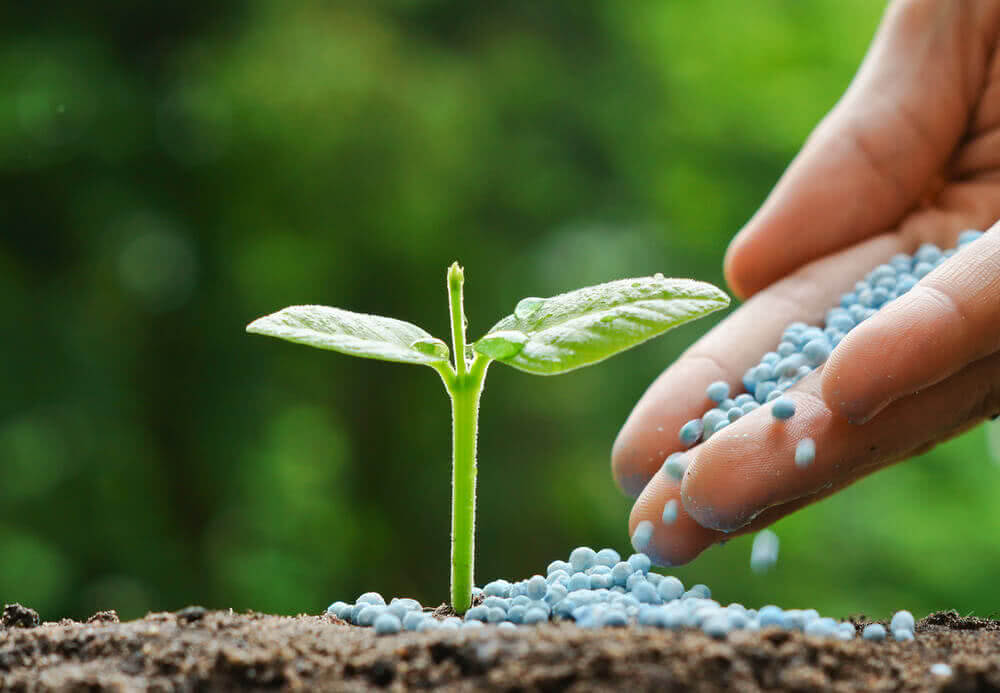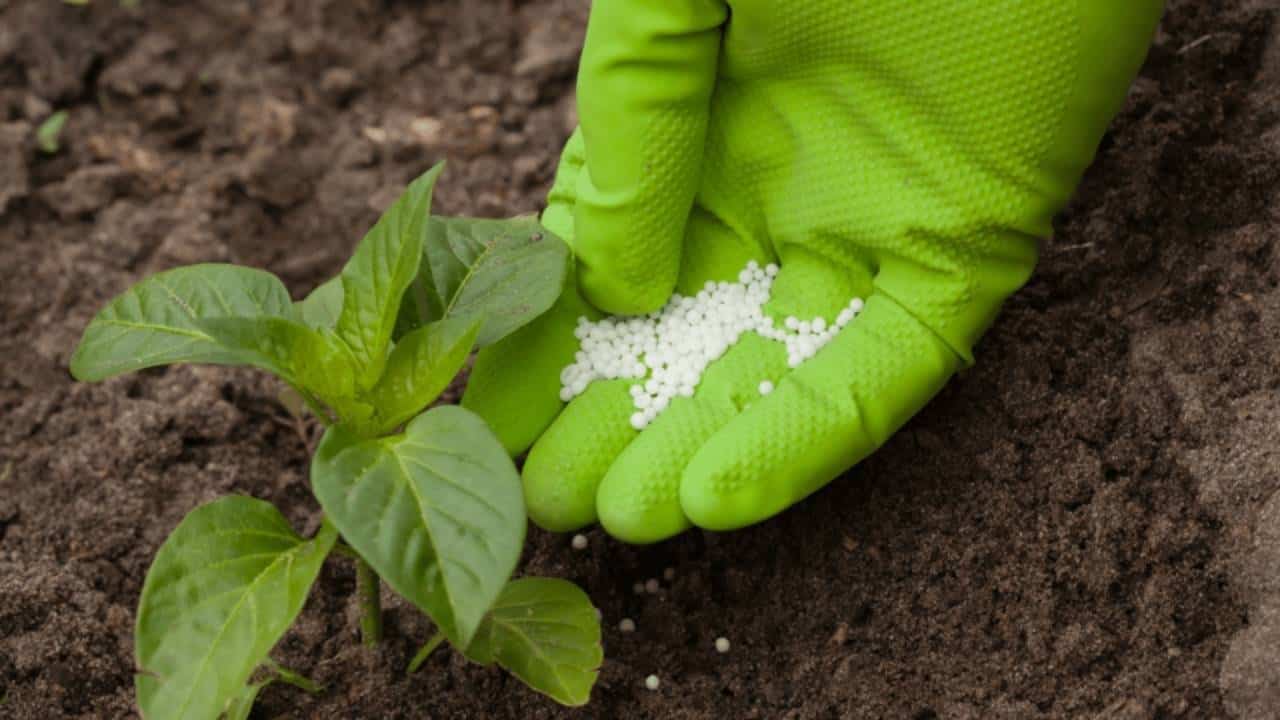Home>Gardening Techniques>What Does Fertilizer Do For Plants


Gardening Techniques
What Does Fertilizer Do For Plants
Modified: February 10, 2024
Discover the importance of fertilizer in plant care and how it nourishes plants for healthy growth. Learn why proper fertilization is essential for thriving plants.
(Many of the links in this article redirect to a specific reviewed product. Your purchase of these products through affiliate links helps to generate commission for Chicagolandgardening.com, at no extra cost. Learn more)
Table of Contents
- Introduction
- The Purpose of Fertilizer
- Nutrient Content in Fertilizer
- The Role of Nitrogen in Plant Growth
- The Importance of Phosphorus in Plant Development
- How Potassium Affects Plant Health
- Secondary Nutrients in Fertilizer: Calcium, Magnesium, and Sulfur
- Micronutrients: The Role of Iron, Zinc, and Copper
- Fertilizer Application Methods
- Potential Risks and Concerns with Fertilizer Use
- Conclusion
Introduction
Welcome to the world of plant care! Whether you’re an experienced gardener or a newbie with a newfound interest in plants, understanding the importance of fertilizer is crucial for maintaining healthy and vibrant plant life. Fertilizer plays a significant role in providing essential nutrients that aid in the growth and development of plants. It serves as a source of nourishment, ensuring that plants receive the necessary elements for optimal health.
Plants, just like humans, require a balanced diet to thrive. While soil naturally contains some nutrients, they may not always be present in sufficient quantities or be readily available for plants to absorb. That’s where fertilizer comes into play. It acts as a supplement, enriching the soil with the nutrients necessary for robust plant growth.
Using the right fertilizer in the correct amounts can make a world of difference in your plant’s overall well-being. However, it’s important to note that not all plants have the same nutritional requirements. Some may thrive in soil with high nitrogen levels, while others might prefer a higher concentration of phosphorus or potassium. Understanding the specific needs of your plants is key to providing them with the appropriate fertilizer.
In this article, we will delve into the various roles of fertilizer in plant care and explore the different nutrients that contribute to healthy plant growth. We will also discuss the application methods for fertilizer and address any potential risks or concerns associated with its use.
So let’s strap on our gardening gloves and dig deep into the world of fertilizer and its vital role in plant care!
The Purpose of Fertilizer
Fertilizer serves a critical purpose in plant care by providing essential nutrients that are necessary for plants to grow and thrive. These nutrients are often lacking in the natural soil, making supplementation with fertilizer crucial for successful plant cultivation.
One of the primary purposes of fertilizer is to supply plants with the necessary macronutrients. These macronutrients include nitrogen (N), phosphorus (P), and potassium (K), commonly referred to as NPK. Each of these nutrients plays a vital role in different aspects of plant health and development.
Nitrogen is crucial for promoting lush, green foliage and supporting leafy growth. It is an essential component of proteins and other organic compounds that plants need to survive. Nitrogen-rich fertilizer helps plants produce chlorophyll, the pigment responsible for capturing sunlight and facilitating the process of photosynthesis. Without adequate nitrogen, plants may develop yellowing leaves and poor overall growth.
Phosphorus, another essential nutrient in fertilizer, is vital for root development, flowering, and fruit production. It aids in the transfer of energy throughout the plant, playing a crucial role in the conversion of sunlight into usable energy. Phosphorus-rich fertilizer is particularly beneficial during the early stages of plant growth when roots are developing. It helps establish a strong root system, enabling plants to absorb nutrients and water more efficiently.
Potassium, the third major nutrient in fertilizer, contributes to overall plant health and resilience. It helps regulate various physiological processes, including water use, enzyme activation, and carbohydrate metabolism. A sufficient supply of potassium promotes sturdy stems, disease resistance, and improved tolerance to extreme temperatures and drought. Potassium-rich fertilizer is especially beneficial for flowering plants and crops that produce fruits or tubers.
In addition to these macronutrients, fertilizer also provides secondary nutrients and micronutrients that are equally important for plant growth. Secondary nutrients, such as calcium (Ca), magnesium (Mg), and sulfur (S), are required in smaller quantities but are still critical for healthy plant development. These nutrients contribute to cell wall formation, enzyme activation, and overall nutrient absorption.
Micronutrients, including iron (Fe), zinc (Zn), copper (Cu), and others, are essential for various enzymatic and biochemical reactions within plants. Although needed in trace amounts, micronutrients are vital for proper plant growth, nutrient uptake, and metabolic processes.
The purpose of utilizing fertilizer is to create an optimal balance of these nutrients in the soil, ensuring that plants have access to the elements they need for robust growth and development. By providing the necessary nutrients, fertilizer acts as a nutritional supplement, helping plants achieve their full potential.
Nutrient Content in Fertilizer
When selecting a fertilizer for your plants, it’s important to understand the nutrient content labeled on the packaging. Fertilizers are typically labeled with three numbers that represent the concentration of the primary macronutrients: nitrogen (N), phosphorus (P), and potassium (K). This labeling system is known as the NPK ratio.
The NPK ratio on fertilizer packaging indicates the percentage, by weight, of each nutrient present in the product. For example, a fertilizer with an NPK ratio of 10-5-5 contains 10% nitrogen, 5% phosphorus, and 5% potassium. These ratios can vary depending on the specific needs of different plants and the stage of growth they are in.
In addition to the NPK ratio, fertilizers may also contain secondary nutrients and micronutrients that are necessary for plant growth. These nutrients are usually present in smaller quantities but are equally important to ensure optimal plant health.
Some fertilizers are formulated for specific types of plants or purposes, such as those designed for flowering plants, vegetables, or acid-loving plants. These specialized formulations may contain additional micronutrients or adjustments in the NPK ratio to cater to the specific requirements of the targeted plants.
It is crucial to choose the right fertilizer based on the specific needs of your plants. Some plants, such as leafy greens like lettuce or herbs, benefit from higher nitrogen levels to promote leaf growth. On the other hand, fruit-bearing plants like tomatoes or peppers require higher phosphorus and potassium levels to support flower and fruit production.
Consider factors such as the soil composition, plant species, and growth stage when selecting a fertilizer. Conducting a soil test can provide valuable insights into the nutrient deficiencies or excesses in your soil, allowing you to choose a fertilizer that addresses those specific issues.
Remember that while fertilizers are necessary for plant health, overuse can be detrimental. Applying excessive amounts of fertilizer can lead to nutrient imbalances, fertilizer burn, and environmental pollution. Carefully follow the recommended application rates and schedules provided on the fertilizer packaging to ensure the optimal use of nutrients without harming your plants.
By understanding the nutrient content in fertilizer and selecting the appropriate one for your plants, you can provide them with the essential elements they need for healthy growth, vibrant foliage, and bountiful harvests.
The Role of Nitrogen in Plant Growth
Nitrogen is one of the primary macronutrients that play a crucial role in plant growth and development. It is essential for the synthesis of proteins, chlorophyll production, and overall plant metabolism. Nitrogen acts as a building block for DNA, RNA, and amino acids, which are the foundation for plant cell structure and function.
One of the key functions of nitrogen is its contribution to leafy growth. It stimulates the production of new cells, resulting in robust foliage development. Adequate nitrogen levels promote a lush green color in leaves, indicating a healthy supply of chlorophyll, the pigment responsible for photosynthesis.
Photosynthesis is the process by which plants convert sunlight, carbon dioxide, and water into glucose and oxygen. Nitrogen is a critical component in chlorophyll molecules, enabling plants to capture sunlight energy and convert it into chemical energy through photosynthesis. Therefore, sufficient nitrogen is necessary for the efficient production of carbohydrates, which provide energy for plant growth and various metabolic processes.
Furthermore, nitrogen plays a vital role in the formation of enzymes and other essential proteins. Enzymes regulate and catalyze biochemical reactions within plants, contributing to numerous physiological processes. Proteins are involved in various structural and functional roles, such as supporting cell walls, transporting nutrients, and defending against pests and diseases.
While nitrogen is essential for plant growth, it is worth noting that excess nitrogen can have detrimental effects. When nitrogen levels are too high, plants may experience rapid vegetative growth, but at the expense of other aspects, such as fruit or flower development. High nitrogen can also make plants more susceptible to diseases and pests.
Furthermore, excessive nitrogen in soil can result in leaching. When rainfall or irrigation exceeds the soil’s ability to retain nutrients, nitrogen can be washed away, potentially polluting nearby water sources. This can have detrimental effects on aquatic ecosystems and human health.
To provide plants with an adequate supply of nitrogen, it is important to choose fertilizers with a balanced NPK ratio or those specifically formulated for nitrogen-heavy applications. Slow-release nitrogen fertilizers are also available, which provide a gradual and sustained release of nitrogen over time, reducing the risk of nutrient leaching.
By understanding the role of nitrogen in plant growth and implementing proper fertilization practices, you can ensure that your plants receive the necessary nutrients for vibrant foliage, healthy metabolism, and overall robust growth.
The Importance of Phosphorus in Plant Development
Phosphorus is an essential nutrient for plant development and plays a crucial role in several key processes throughout a plant’s life cycle. It is involved in energy transfer, root development, flowering, fruit production, and overall plant metabolism.
One of the primary functions of phosphorus is its role in energy transfer and storage. Phosphorus is a key component of adenosine triphosphate (ATP), the molecule responsible for storing and transferring energy within cells. ATP fuels metabolic reactions, enabling plants to carry out essential processes such as photosynthesis, respiration, and nutrient uptake.
Phosphorus also plays a major role in root development, particularly during the early stages of a plant’s life. It helps encourage vigorous root growth, promoting the formation of a strong and extensive root system. A well-developed root system enhances a plant’s ability to absorb water and essential nutrients from the soil, ensuring its overall health and vitality.
In addition to root development, phosphorus is vital for flower and fruit production. Adequate levels of phosphorus during the flowering stage can enhance the formation, size, and quality of flowers. It also contributes to the development and maturation of fruits, resulting in higher yields and improved crop quality.
Phosphorus is involved in several metabolic processes essential for plant growth and health. It aids in the synthesis of nucleic acids, which are the building blocks of DNA and RNA. These compounds are vital for cell division, growth, and reproduction. Phosphorus is also a component of phospholipids, which are key constituents of cell membranes.
Furthermore, phosphorus promotes the activation and transfer of other essential nutrients within the plant. It assists in the movement and conversion of sugars, lipids, and proteins, facilitating the transport of nutrients to where they are needed and optimizing their utilization.
While phosphorus is vital for plant development, it is worth noting that excessive phosphorus levels can have negative effects. High levels of phosphorus in soil can lead to nutrient imbalances and environmental pollution. Additionally, certain soil types, such as those rich in clay, can easily retain phosphorus, making it less available to plants. Regular soil testing can help determine the phosphorus levels and guide the appropriate fertilizer application.
To ensure plants receive adequate phosphorus, it is crucial to select fertilizers with a balanced NPK ratio or those specifically formulated to provide higher levels of phosphorus. Applying phosphorus-rich fertilizers during the early stages of plant growth and flowering can boost root development, flower formation, and fruit production.
By understanding the importance of phosphorus in plant development and implementing proper fertilization practices, you can promote healthy root systems, vibrant flowers, and abundant fruit production in your plants.
How Potassium Affects Plant Health
Potassium is a vital nutrient for plant health and plays a crucial role in various physiological processes. It is involved in maintaining overall plant vigor, root development, water regulation, disease resistance, and the transportation of nutrients.
One of the primary functions of potassium is its role in regulating water balance within plants. It helps plants maintain turgor pressure, which is the internal pressure that keeps cells firm and upright. Adequate potassium levels enable plants to efficiently absorb and utilize water, even during periods of drought or excessive heat. This helps prevent wilting and ensures that plants can continue to carry out essential processes like photosynthesis.
Potassium also plays a significant role in supporting root development. It acts as a catalyst for multiple enzymes involved in root growth and development. A healthy root system is crucial for absorbing water, nutrients, and anchoring the plant in the soil.
In addition to water regulation and root development, potassium contributes to disease resistance and overall plant vigor. It strengthens plant cell walls, making them less prone to invasion by pathogens and pests. Strong cell walls also contribute to the structural integrity of plants, helping them withstand environmental stresses such as wind and heavy rain.
Potassium is involved in the transportation of nutrients within plants. It helps move nutrients from roots to shoots and leaves, ensuring that plants have a steady supply of the essential elements they need for growth and development. This nutrient transport aids in the synthesis of carbohydrates, proteins, and other vital compounds necessary for plant metabolism and overall health.
Furthermore, potassium influences the opening and closing of stomata, the tiny pores on the surface of leaves that regulate gas exchange and water vapor loss. Proper stomata function is essential for photosynthesis and the efficient use of water, as it allows plants to take in carbon dioxide and release oxygen while minimizing water loss through transpiration.
While potassium is essential for plant health, it is important to maintain proper balance with other nutrients. Excessive potassium can inhibit the uptake of other minerals, leading to nutrient imbalances. Regular soil testing can help monitor potassium levels in the soil and guide appropriate fertilizer application.
To ensure plants receive adequate potassium, it is crucial to select fertilizers with a balanced NPK ratio or those specifically formulated to provide higher levels of potassium. Applying potassium-rich fertilizers during periods of active growth and fruiting can help promote disease resistance, strong root development, and overall plant vigor.
By understanding how potassium affects plant health and implementing proper fertilization practices, you can cultivate strong, resilient plants that are better equipped to withstand environmental stresses and produce abundant, high-quality yields.
Secondary Nutrients in Fertilizer: Calcium, Magnesium, and Sulfur
In addition to the primary macronutrients (nitrogen, phosphorus, and potassium), plants also require secondary nutrients, albeit in smaller quantities, for their healthy growth and development. Three essential secondary nutrients found in many fertilizers are calcium, magnesium, and sulfur.
Calcium plays a crucial role in plant cell wall development and overall plant structure. It helps form and strengthen cell walls, providing structural support to plants. Adequate calcium levels promote stronger stems and branches, reducing the risk of lodging or breakage, especially in tall plants or during periods of heavy fruit or flower production.
In addition to cell wall formation, calcium is involved in numerous physiological processes within plants. It aids in the regulation of cell membrane permeability, enzyme activity, and hormone balance. Calcium also helps transport other nutrients throughout the plant, ensuring their availability in different tissues.
Magnesium is an essential nutrient for chlorophyll synthesis, which is vital for photosynthesis. It is a central component of the chlorophyll molecule, enabling plants to capture sunlight energy and convert it into chemical energy. Magnesium deficiency can lead to yellowing leaves, as the chlorophyll production is impaired.
Aside from its role in chlorophyll synthesis, magnesium is involved in various enzymatic reactions within plants. It activates enzymes required for DNA and RNA synthesis, protein metabolism, and energy transfer. Magnesium also helps in regulating the uptake and utilization of other essential nutrients, such as phosphorus and potassium.
Sulfur is necessary for the synthesis of certain amino acids and proteins. It plays a crucial role in the structure and functionality of proteins, enzymes, and vitamins. Sulfur is particularly essential for plants that require high protein content, such as legumes and oilseed crops.
Sulfur is also involved in the production of secondary metabolites, such as essential oils and pigments, contributing to the flavor, fragrance, and color of fruits, vegetables, and herbs. It aids in plant defenses against pests and diseases, as some secondary metabolites have antimicrobial and insecticidal properties.
As with any nutrient, excess or deficiency of calcium, magnesium, or sulfur can lead to nutrient imbalances and affect plant health. Soil testing can help determine the nutrient levels, enabling growers to make informed decisions regarding fertilizer application.
When selecting fertilizers, look for those that provide a balanced supply of secondary nutrients. Many fertilizers contain these nutrients in addition to the primary macronutrients, ensuring plants receive the well-rounded nutrition they need for healthy growth. However, it’s worth noting that some specific crops or soil conditions may require supplementary applications of calcium, magnesium, or sulfur fertilizers to address specific deficiencies.
By understanding the importance of secondary nutrients in plant nutrition and incorporating them into your fertilization practices, you can promote optimal plant structure, metabolic processes, and overall health.
Micronutrients: The Role of Iron, Zinc, and Copper
In addition to the primary macronutrients and secondary nutrients, plants require small amounts of micronutrients for their healthy growth and development. Micronutrients are essential elements that plants need in low concentrations but are still crucial for various physiological processes. Three important micronutrients found in many fertilizers are iron, zinc, and copper.
Iron plays a vital role in chlorophyll formation and the production of enzymes involved in energy transfer. It is an essential component of several enzyme systems, playing a crucial role in plant metabolism and respiration. Iron deficiency can result in yellowing leaves, a condition known as chlorosis, as it affects the plants’ ability to produce sufficient chlorophyll.
Zinc is involved in several essential plant functions, particularly in enzyme activation and protein synthesis. It aids in hormone production, pollen formation, and overall plant growth and development. Zinc deficiency can lead to stunted growth, distorted leaves, and poor fruit or seed development.
Copper is necessary for several enzymatic reactions within plants. It is involved in the process of lignin synthesis, which strengthens cell walls and contributes to plant structure. Copper plays a role in reproductive processes, such as seed production and pollen formation. Its deficiency can result in wilting, leaf discoloration, and reduced fruit production.
Each of these micronutrients serves a critical role in promoting plant health and function. However, it is important to note that micronutrient deficiencies or toxicities can occur in soils with imbalanced pH levels or specific soil characteristics. Regular soil testing can help identify any micronutrient deficiencies and guide appropriate fertilizer application.
Fertilizers that contain micronutrients are available in various formulations. Some fertilizers are specifically designed to provide a mix of essential micronutrients, ensuring that plants receive a balanced supply. These fertilizers may also be supplemented with other trace elements like manganese, molybdenum, or boron, depending on the specific crop and soil requirements.
When using fertilizers that contain micronutrients, it is important to follow the recommended application rates and guidelines provided on the packaging. Overapplication of certain micronutrients can be harmful to plants and may even lead to soil contamination.
By understanding the role of micronutrients such as iron, zinc, and copper, and implementing proper fertilization practices, you can ensure that your plants receive the essential elements they need for optimal growth, development, and overall health.
Fertilizer Application Methods
Applying fertilizer correctly is crucial to ensure that plants receive the necessary nutrients for healthy growth and development. There are several common methods for applying fertilizers, each with its advantages and considerations.
The most straightforward and commonly used method is broadcasting. Broadcasting involves evenly spreading the fertilizer over the soil surface using a spreading tool or by hand. This method is suitable for large areas or open fields and allows for the nutrients to be gradually incorporated into the soil through rainfall or irrigation. It is important to follow recommended application rates and avoid over-application, as excess fertilizer can leach into water sources or cause nutrient imbalances.
For smaller areas or potted plants, side-dressing is a suitable technique. Side-dressing involves applying fertilizer in a shallow trench or along the sides of rows or specific plant areas. This allows for targeted nutrient delivery closer to the root zone of individual plants, ensuring efficient uptake and utilization. Side-dressing can be especially beneficial for crops that have specific nutrient needs during different growth stages or for plants with shallow root systems.
Another method is fertigation, which involves applying liquid fertilizer through an irrigation system. Fertigation allows for a precise application of nutrients directly to the root zone, ensuring efficient nutrient uptake. This method is commonly used in commercial agriculture as it provides control over nutrient application rates and timing. Fertigation can also help minimize nutrient losses through leaching or volatilization.
Foliar spraying is a technique where fertilizer is applied directly to the leaves of plants. It involves diluting the fertilizer in water and spraying it onto the foliage. Foliar spraying is useful when rapid nutrient delivery is needed or when there are observed nutrient deficiencies. The foliage absorbs the nutrients through the stomata or leaf surface, allowing for quick utilization by the plant. However, it is important to follow proper dilution ratios and avoid spraying during hot, sunny periods to prevent leaf damage.
Soil incorporation is a method where fertilizers are mixed into the soil before planting or during soil preparation. This ensures that the nutrients are evenly distributed in the root zone and readily available for plant uptake. Soil incorporation is commonly used for slow-release or organic fertilizers that require time to break down and release nutrients gradually.
When choosing a fertilizer application method, consider factors such as the type of plants, soil conditions, and nutrient requirements. It is also important to read and follow the instructions on the fertilizer packaging to ensure safe and effective application.
By selecting and implementing the appropriate fertilizer application method for your specific gardening needs, you can provide your plants with the right nutrients at the right time, promoting healthy growth and maximizing their full potential.
Potential Risks and Concerns with Fertilizer Use
While fertilizers play a crucial role in supporting plant growth, it’s important to understand and address potential risks and concerns associated with their use. Here are some key considerations:
Environmental Impact: Improper use or over-application of fertilizers can lead to environmental pollution. When excess nutrients, such as nitrogen and phosphorus, enter water bodies through runoff or leaching, they can cause eutrophication. This can result in algal blooms, oxygen depletion, and harm to aquatic ecosystems. It is important to carefully follow recommended application rates and timings to prevent nutrient runoff.
Water Quality and Human Health: Fertilizers that contain nitrates can contaminate groundwater, affecting the quality of drinking water. High nitrate levels in drinking water can pose health risks, particularly for infants and pregnant women. It is essential to be mindful of the proximity of fertilizer application to wells or water sources and adhere to guidelines for protecting water quality.
Soil Degradation: Overreliance on synthetic fertilizers without proper soil management practices can lead to soil degradation over time. Continuous application of fertilizers without considering soil health and organic matter content can result in nutrient imbalances, altered microbial activity, and reduced soil fertility. It is advisable to incorporate organic matter, practice crop rotation, and conduct regular soil testing to maintain soil health.
Plant Toxicity: Excessive application of fertilizers can result in nutrient imbalances and toxicity in plants. For example, excessive nitrogen can lead to rapid vegetative growth at the expense of fruiting and flowering. Overuse of certain micronutrients like copper or zinc can also be toxic to plants. It is crucial to carefully follow recommended application rates to prevent nutrient toxicity.
Impact on Beneficial Organisms: High levels of synthetic fertilizers can be detrimental to beneficial soil organisms, such as earthworms and beneficial microbes. These organisms play crucial roles in soil fertility, nutrient cycling, and overall ecosystem health. Organic fertilizers or slow-release formulations can be more environmentally friendly and promote a healthier soil ecosystem.
Chemical Runoff: Some fertilizers contain chemicals that may be harmful to non-target plants, insects, and wildlife if runoff occurs. It is important to be mindful of potential runoff and avoid fertilizing near sensitive areas like streams, wetlands, or natural habitats. Opting for natural or organic fertilizers can help minimize the risk of chemical runoff and its impact on the environment.
To mitigate these risks and concerns, it is important to adopt responsible fertilizer use practices. Consider using slow-release fertilizers that release nutrients gradually, matching the nutrient requirements of the plants. Proper timing, calibration of application equipment, and following recommended application rates can prevent nutrient imbalances and minimize environmental impacts. Additionally, incorporating organic matter, practicing proper soil management, and implementing conservation practices can help maintain soil health and reduce reliance on synthetic fertilizers.
By acknowledging and addressing the potential risks and concerns associated with fertilizer use, you can promote environmentally sustainable and responsible plant care practices, ensuring the well-being of your plants and the surrounding ecosystem.
Conclusion
Fertilizer plays a vital role in plant care, providing essential nutrients that support healthy growth, development, and overall plant health. Understanding the purpose and function of fertilizers is key to ensuring that plants receive the necessary nutrients they need to thrive.
The primary macronutrients, including nitrogen, phosphorus, and potassium, are essential for various aspects of plant growth. Nitrogen promotes lush foliage, phosphorus supports root development and flowering, and potassium contributes to overall plant vigor and water regulation.
In addition to the primary macronutrients, secondary nutrients such as calcium, magnesium, and sulfur, and micronutrients like iron, zinc, and copper, also play crucial roles in plant nutrition. These nutrients contribute to cell structure, enzyme activation, metabolic processes, and overall plant health.
When applying fertilizers, it’s important to consider factors such as the specific nutrient requirements of plants, soil conditions, and appropriate application methods. Broadcasting, side-dressing, fertigation, foliar spraying, and soil incorporation are common methods used to provide nutrients to plants efficiently.
However, it’s essential to be aware of potential risks and concerns associated with fertilizer use. Environmental impacts, water pollution, soil degradation, nutrient toxicity, and chemical runoff are some of the risks that need to be managed properly through responsible fertilization practices.
To ensure the effective and responsible use of fertilizers, it is advisable to conduct soil tests to determine nutrient deficiencies or excesses, choose fertilizers with balanced nutrient ratios, follow recommended application rates, and consider alternative options like organic fertilizers or slow-release formulations.
By understanding the importance of fertilizers and implementing proper fertilization practices, you can help your plants thrive, promote sustainable gardening practices, and contribute to the preservation of our environment.








